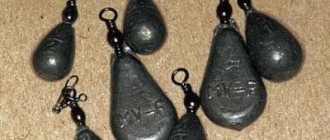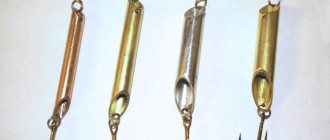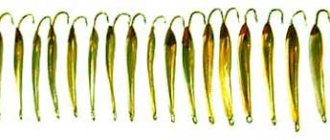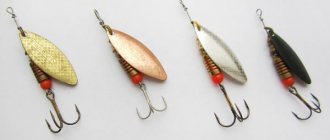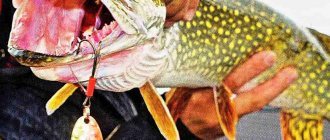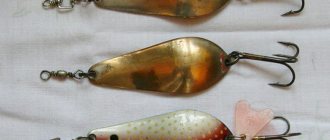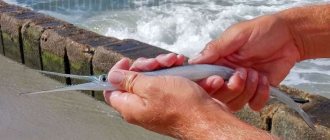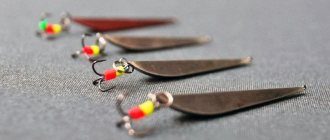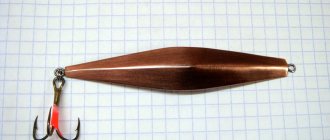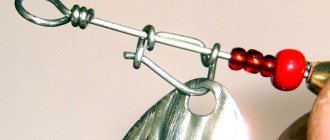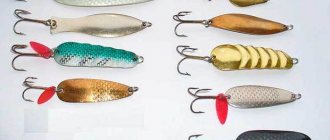Types of bait for pike
When fishing for pike using a spinning rod with any of the baits, correct wiring plays one of the most important roles. In the process of passing through the water column, the bait used should maximally imitate a wounded fish that is trying to escape from a predator. Only in this case will the pike pay attention to the offered bait and go on the attack.
Experienced fishermen most often use several types of basic wiring, each of which has its own characteristics and is used for certain baits. It is advisable for beginners to get acquainted with the varieties before going to the reservoir, and there it is worth practicing the subtleties in practice.
Fishing for pike with a spoon
Spoon baits are still popular, despite all the efforts of companies producing new baits for catching predators. Oscillating spoons are also popular because they are easy to catch. They forgive wiring flaws.
Moreover, pike often take just any kind of wiring. Apparently the fish sees in the unevenly twitching spoon a completely wounded creature and easy prey. The spinner catches immediately after falling into the water - playing while diving. This fishing technique cannot really be repeated with any other bait.
And refined techniques for guiding spinners allow you to achieve the largest pike catches. Many anglers claim that it is the spoon that brings the most trophies compared to other baits. But how do they achieve this, how to successfully catch pike with a spoon? Nothing complicated, simple techniques...
Wiring Features
Playing at great depths with small and medium-sized spoons is almost impossible. At depth, only a heavy, oscillating spoon can be used successfully. But it can also be carried out in the middle layers of water.
Pike also prefer medium and large spoons. Moreover, the colder the water, the closer to winter, the more relevant a large heavy spoon becomes.
The simplest wiring of the vibrator, but very effective - uniform movement. And that’s it – the spinner does its job! For beginner spinners - a fairy tale...
The usual rule for catching pike with a spinner is to make the retrieve as slowly as possible, at the limit of the spinner’s ability to oscillate when moving.
But it is important to know the desired horizon and maintain it. For example, in the fall, pike loves depth and stands on the edges, slopes into the hole. You need to lift a heavy spoon along the edge from the depths, or even better, from the opposite direction, roll the spoon from the shore to the depths, imitating the usual movement of prey. In summer, there are a lot of pike where small fish are found - in overgrown shallow waters. And here there are some peculiarities of fishing.
A decent pike took the bait on a dive near the reeds
Unhooked ones are caught in shallows and snags
In summer, overgrown shallow waters are just suitable for light spinners. And the main predator is the grass pike, not large, but very aggressive towards the spooner that makes its way between the stems.
Non-hook spinners are spinners in which the hook is covered by metal antennae to prevent accidental snagging. Indeed, they can be carried out along snags and grass - very promising places for fishing. When the pike grabs the bait, the antennae contract and the predator gets hooked.
It is believed that on a non-hook it is better to use a single rigid hook protected by antennae. It catches pike more effectively than a tee with such protection. More information about catching pike in the grass with a wobbler
But if we talk about the effectiveness of fishing with various baits, then there is an opinion that with an oscillating spoon the percentage of strikes during bites is higher than with any other baits. This is due to the shape and material - the spoon easily slips through the mouth, and the hook reaches the target faster.
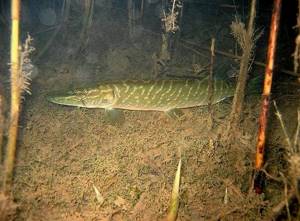
Various spinner game options
With uniform wiring everything is clear - effective, but according to the mood of the fish. If the pike is lethargic and stubbornly does not want to take a simple movement, then you can tease it. Make an up and down motion, like a step. The fall of the spoon is very effective. Performed as winding with pauses.
Another variety of wiring is to place the spoon on the bottom, then lift it to create turbidity. The predator comes running to such an event.
The next twitching movement is a jerky reeling and twitching with the tip of the fishing rod.
Using these combinations, you gain your own experience in “driving” the spinner. But when the pike is actively greedy, a simple uniform movement of the spoon is enough. It should be taken into account that uniform wiring is the most rational. With it, the overall speed of movement of the spoon is greater, and a larger area is fished during the activity of the pike. As a result, there is a greater likelihood of encountering a predator and a greater number of bites.
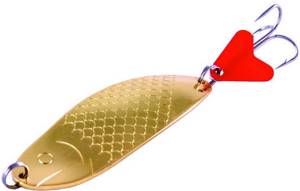
Primary catch on the fall
The spinner plays on the fall. The predator reacts to it. It is better to first check an unfamiliar place with a fall technique. The point is that the oscillating spoon is allowed to sink freely. A pike, if it is close in ambush, may well take it right there. But more often it happens a little differently.
The spinner, plunging, attracts a predator to the place, especially if the depth is deep and an interested pike approaches the object for exploration. After this, the spoon is allowed to lie on the bottom for a minute or more - so that the pike comes up and gets used to the situation - the fish needs time to study. Then the spoon is lifted from the bottom to create turbidity, at which time the bite occurs. The pike is guided by a reflex - as soon as the object begins to run away, it takes it.
This is how they fish for snags sticking out of the water, they fish for reed walls and vegetation in windows. But even in open water, at depth, it is useful to begin examining a place with a free dive.
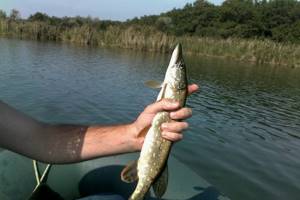
Seasonality of fishing
Cold water in spring and autumn, the concentration of fish in holes, require the angler to adapt to the behavior of pike - to fish at great depths along the edges. The wiring is usually stepped, often with dragging along the bottom. The spinners are heavy. Sometimes fast retrieval is better - the pike still takes, and the catch is wider.
In summer, in warm water, the opposite is true - lighter lures, higher stroke, above the grass, above the snags. Even at depth - at half-water. The usual technique of a predator is to stand lower, merging with the bottom, and attack from the bottom up. This is how they catch summer pike. But the wiring is only extremely slow, mostly uniform. Light oscillating spoons actively play with this movement.
It turns out that pike can be successfully caught not only during the day but also at night. How to catch pike in the dark - new article.
taut line
When doing any wiring with an oscillating lure, you need to learn to keep the line taut. This is especially true for the fall phase of the spinner. With a tight line, the bite is easy to detect. And with a slack bite, the bite will go unnoticed.
The pike quickly determines that it has grabbed something unnecessary and frees itself from the spoon. With silicone, for example, there is still some reserve of time, especially if it is odorous, then the pike may try to drag it away. But with a spinner, the catch for the fish is obvious, so more often the predator tries by all means to part with the foreign object. To prevent the pike from spitting out the bait, you need to constantly monitor the movement of the fishing line and make a quick hook if there is any suspicion of a bite.
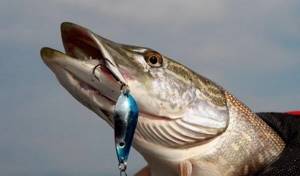
Shine matters
In clear cold water, golden and silver, highly reflective vibrators tend to work worse. They probably create a light effect in such conditions that is too bright for the fish. Therefore, in the fall, fish most likely will not like silver and golden “beauties”. You need something dark, blued, gloomy-looking and not colorful. In general, color and reflection matter to a spinner.
In summer, when the water is cloudy, shiny ones, on the contrary, more often tempt pike. Most likely, the increased light visibility in such water is a useful addition to the sound stimulus. Of course, this is not a hard and fast rule, but you need to remember about the selection of color and light.
Fishing from a boat
Fishing from the shore is significantly limited. Being on the shore, you cannot reach or reach the best edges, windows of vegetation, snags and simply great depths, where they mainly catch trophy channel pike with heavy lures...
But with a boat, the choice of fishing spots expands beyond words. Especially if the vessel is equipped with at least an electric motor. Fishing from the shore, casting under the wall of reeds and much more becomes available.
It is equally important that the hook of the spinner is no longer its last act of action. On a boat, using a heavy hitch and a long stick, you can solve such problems. Moreover, branded modern spinners are not cheap. And which of the spoons are more catchy?... It’s better to look for answers yourself in fights with pike in summer and autumn. Read more - what techniques can be used when fishing with a spinning rod
Uniform
Everyone knows how to do this type of wiring correctly, sometimes without even suspecting it. When fishing for pike, this method is considered the simplest and most accessible even to children. The main role here will be played by the bait itself; the successful outcome of the started business depends on it. The tackle with bait is thrown to a given point and they wait until the bait sinks to the bottom. After this, they begin unhurried work with the reel, the essence of which is to uniformly and unhurriedly wind the warp.
To achieve a better effect, sometimes you can take short pauses and then reel in the line again. Usually it is during the pause that the pike attacks the offered bait.

Uniform method
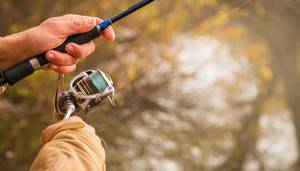
Uniform spinning retrieve is the best option for a beginner. It involves the simplest actions of the fisherman: uniformly winding the fishing line onto the spool at a constant speed. In this case, the spinning rod remains in the same position: the fisherman operates exclusively with a reel. The winding speed can be different, and the depth of immersion depends on this factor. The higher it is, the faster the bait comes to the surface. It is usually used when fishing in the middle and upper layers of water, which virtually eliminates the possibility of snags on a snagged bottom.
Despite the simplicity of execution, this method sometimes produces very high catchability. Moreover, some baits, for example, “spinners” with a core weight, demonstrate real play only with this method of execution. Other baits (spinners, wobblers with their own game, jigs) can be animated in both the above and other ways.
Stepped
Step-by-step targeting of a predator is carried out in two ways, each of which will be no less effective. The point is that the bait moves in a zigzag pattern in the water column, then rises and then falls to the bottom again. Let's look at each of them in more detail:
- Using a reel it is not difficult to make the bait move like this. It is enough to wait until the bait completely sinks to the bottom, then make 2-3 turns with the handle, stop and again wait for the bait to touch the bottom. Then the steps are repeated all the way to the coastline. The speed of lowering directly depends on the speed of rotation of the handle.
- With a rod, this wiring for pike is carried out a little differently. Immediately after casting, we wait until the bait is completely lowered to the bottom, then we make a sharp jerk with the blank so that the bait used rises above the bottom by about 15 cm. And at the same moment we reel in the slack of the base with the reel. Next, we again wait for the bait to be completely immersed and again make a jerk. An important point with this method will be maintaining tension in the line, which allows you to fully control the bait.
This wiring is used by many; it is one of the most used for various types of baits. The attention of the predator is attracted not only by the zigzag movements of the bait, but also by the turbidity created by it as it falls to the bottom. In addition, with bait it becomes possible to create a specific sound, which additionally attracts ichthyans.
How to choose a spinner: some practical tips
When choosing a lure, it is necessary to take into account fishing conditions, such as time of year, weather conditions, time of day, depth and strength of the current in the intended fishing location and similar factors.
In addition, before purchasing a bait that is optimal in weight, shape, size, game pattern and color, you should, of course, be guided by what kind of fish you are going to catch with it.
Consequently, to catch large predatory fish with a wide mouth, large spoons will be needed, and, accordingly, for smaller predators such as perch, pike perch and ide, it is more convenient to use smaller baits.
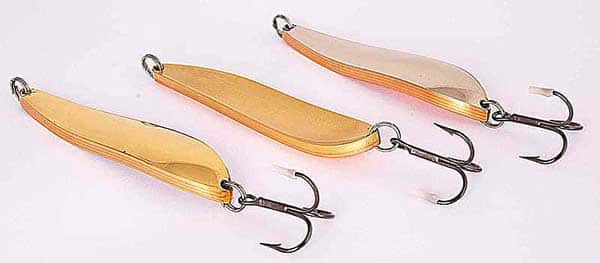
It often happens that when a fisherman finds himself in a new, unfamiliar fishing spot and gets bites one after another on a certain lure, he decides that this bait is “catchy” and puts this tackle on his list of favorites.
However, under other conditions, for example, different weather and lighting, in the same place the previously “catchy” spoon does not give the expected result, and a completely different, previously ineffective bait turns out to be successful.
Also, when choosing a spoon, you should take into account such nuances as the number of fishermen visiting a stagnant body of water. Often in such places the fish, as they say, have already “become acquainted” with various wobblers, spinners and other artificial baits.
In this case, a spinner of an asymmetrical shape can be very useful, the peculiar instability of the game of which has not yet become boring to the fish, and accordingly, will not cause them concern.
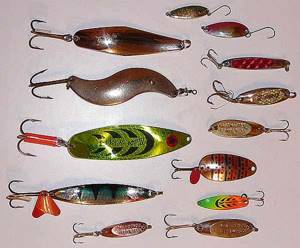
3 ways to improve your fish bite!

Over 15 years of active fishing, I have found many ways to improve the bite, and here are the most effective:
1. Bite activator . This pheromone additive attracts fish most strongly in cold and warm water. The Fish Hungry bite activator has proven itself to be excellent - Read more…
2. Tackle with increased sensitivity . You should first familiarize yourself with the features of using a particular type.
3. Pheromone baits . They attract the attention of fish, stimulate hunger and cause a schooling reflex, which allows you to collect a lot of fish in one place.
You can get the rest of the secrets of successful fishing for free by reading my other materials on the site.
3 ways to improve your fish bite!
Over 15 years of active fishing, I have found many ways to improve the bite, and here are the most effective:
1. Bite activator . This pheromone additive attracts fish most strongly in cold and warm water. The Fish Hungry bite activator has proven itself to be excellent - Read more…
2. Tackle with increased sensitivity . You should first familiarize yourself with the features of using a particular type.
3. Pheromone baits . They attract the attention of fish, stimulate hunger and cause a schooling reflex, which allows you to collect a lot of fish in one place.
You can get the rest of the secrets of successful fishing for free by reading my other materials on the site.
A big role for the quality of play of a bait is its profile or the depth of stamping - the deeper, the slower and more stable its oscillations when retrieving, for example, the popular S-shaped model makes short, as if yawing movements. This form is considered optimal for fishing in fast currents.
Aggressive
This type is very similar to the previous one, performed using a spinning blank. The difference is that the jerks are performed as hooks, then the bait, sinking to the bottom, will make slight oscillating movements.
This type of wiring is used for active fish when the water temperature rises to 15 degrees or more.
Design of catching oscillators
Oscillating spoons are attached to a fishing line (leash) using a winding ring. The width of the tee is equal to the width of the spoon in its lower part. The weight of the tee should be small so as not to hamper the movement of the spoon: a very large and heavy hook outweighs it, and the spoon does not “play”, but is pulled flat behind the fishing line.
For fishing in grassy and snagged areas, spoons with a single hook tightly attached to the body of the spoon are good. Hooks can be avoided altogether if a loop of steel wire with a diameter of 0.2-0.25 mm is soldered to the lure, covering the tip of the hook.
The ratio of length to width of a good oscillating spoon should be in the range from 3 to 4. The smaller this ratio, the more energetically the spoon “plays” when moving in the water. Short, wide spoons are quite mobile, but their play is unstable - when the speed of movement increases, they begin to rotate randomly. On the contrary, the longer the spoon (and the greater the ratio of length to width), the weaker its “game”. That is why highly elongated spoons are made “double-bent”, that is, curved both in width and length.
To make the spoon more attractive to predatory fish, a thin plastic petal of red or red-brown color is hung on the winding ring to the tee. Such an addition, without worsening the “game” of the spinner, actually makes it more catchy.
Twitch
Fishing for pike by twitching will bring more trophies in the autumn, when the predator is aggressive and attacks actively moving baits. There are no specific rules and conditions for this type; it all depends on the fisherman himself and his skills.
The most used is the so-called acceleration-deceleration, one might say this is the basis of wiring. Immediately after casting, you need to wait until the bait touches the bottom, then they begin to slowly reel in the base, after a couple of turns with the reel they begin to accelerate, it is carried out with 3-4 turns, then they return to the primary method.
Acceleration-deceleration is carried out only by a coil; other elements can be added. Moving with a blank will work well when the underbrush needs to be pulled out additionally.
Stop end go
This method has proven itself to be the best wiring for a wobbler, especially two- and three-piece ones. The essence of the method is that immediately after casting, out of habit, we expect the bait to be completely immersed and touch the bottom. Then we make 3-5 turns of the coil as slowly as possible and stop. Then the cycles are repeated with the same amplitude.
The bait will arouse the predator’s interest almost immediately, but the attack usually occurs when it stops.
In addition to those described above, there are many more spinning fishing rods. Fishermen with experience know that in this matter the main thing is not to be afraid of experiments; introducing your own innovations to already proposed methods is not only possible, but also necessary.
Jig wiring
With the advent of silicone nozzles, the capabilities of spinning anglers have expanded significantly. Among them, the most popular are twisters and vibrotails (baits with jig heads), but fishermen also use this technique with other options, for example, foam rubber fish, known since Soviet times. Sometimes jigs are also used to catch peaceful fish, with passive silicone baits that imitate insects, worms, crustaceans, and so on. So, for example, a silicone worm can be used by bream, carp or crucian carp.
Jig fishing is highly effective year-round, but it is most productive in spring and autumn. However, in non-freezing reservoirs, jig lovers catch predators in winter - peaceful fish are inactive at this time.
This technique uses rods with different tests and action. The characteristics of a spinning rod are, for the most part, determined by the weight of the bait with the head, but other factors are also taken into account, for example, the strength of the current. At long distances, as in the previous case, the best option is a braided line; at short distances and with inactive fish, a monofilament line that is less noticeable in the water is the best option.
The essence of the classic jig is to give the bait a stepwise movement. The bait sinks to the bottom when casting, followed by a stage of reeling out the fishing line and a pause, during which the bait sinks deeper again. The vast majority of bites occur during the free fall stage, but sometimes the predator reacts to potential prey at other times.
Russian classics
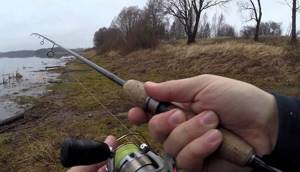
In this case, we are talking about the classic Russian step, perhaps the most common and universal wiring, suitable for “silicone” baits with jig heads. It is considered most effective in rivers, but can also be used in reservoirs with standing water. The predator responds best to it when fishing with the current, but when the fish are highly active, the opposite option is also applicable.
The classic spinning technique is as follows:
- After casting, the angler waits for the moment when the bait sinks to the bottom (often the attack follows precisely at this moment).
- When you touch the bottom, you should wind the reel a couple of turns, the bait will float up.
- There is a pause, during which the bait touches the bottom again.
Similar movements are repeated until the bait approaches the shore. In the classic version, the number of windings and the weight of the bait are selected in such a way that the average time of lowering the bait to the bottom, tempting for fish, is about 2-5 seconds with a step step of about 1-3 meters.
The slow version with pauses after the fall and short reels is effective in cold water and inactive fish. In conditions of a clean bottom, it can be supplemented with dragging, to which perch and pike perch respond especially well.
American version
If the classic method involves working exclusively with a reel, then the American version also uses a rod. This technique works best in still water, but some anglers use it productively in currents, especially when hunting walleye. Many spinning anglers value this wiring for its maximum sensitivity to the animation of the silicone: all its movements are instantly transmitted to the angler’s hand.
When the bait falls to the bottom, the angler smoothly pulls the rod towards himself, and then winds the reel to eliminate the slack. The next pull-up and jerk follows after the bait falls again. The step pitch in this case directly depends on the length of the spinning rod, so with short “American” rods it is almost impossible to do.
To be demolished
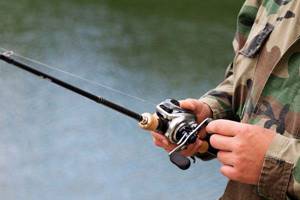
“Download” fishing is an interesting and productive fishing technique on rivers with a noticeable current, especially in cold water. In fact, it can be called a variation of the above-mentioned “American”, adapted to river conditions. This method requires certain skills and feel for the rod, so beginners are better off practicing with simpler options.
In this case, casting is usually carried out upstream. After the bait falls, the fisherman lifts it above the bottom by swinging the rod (without reeling), which allows it to float a meter or two downstream. Then the operation is repeated cyclically until the slack of the fishing line becomes critical. After this moment, the coil is wound and any of the techniques suitable for working against the current are used, for example, the same classic.
Pendulum
This method is used in difficult fishing conditions: the equipment in this case is subject to minimal risk of snagging. When fishing in snags, it is recommended to use a flat jig head: it is less “catchy” than a round one. If desired, the pendulum can also be operated with the flow, under demolition.
The pendulum diagram looks like this:
- At the beginning of the retrieve, immediately after the bait falls, the angler moves the spinning rod to a horizontal position and pulls it 10-15 cm.
- The bait rises above the bottom, after which the rod returns back 5-10 cm.
- It falls to the ground, the slack in the fishing line is taken out, and the form returns to the horizontal.
Aggressive wiring
As we already said above, the more active the fish, the sharper and faster the wiring should be. Therefore, the aggressive technique is only suitable for a hungry and active predator, for example, during the pre-spawning period. The object of hunting can be any representative of the predatory ichthyofauna: from trophy pike perch to small grass perch. The main rule: the fish must see the target well, so in poor lighting conditions and in muddy water, aggressive fishing is ineffective.
This technique is not too difficult to perform. It involves a sharp upward swing of the rod, like a hook, and then lowering it almost to the horizontal in combination with reeling in the fishing line. As a result of jerks, very short steps are formed.
Dotted line
We have before us another interesting technique, applicable to a passive predator: it works in the absence of a bite. True, for beginners who have just picked up a spinning rod, this wiring will seem overwhelming: it requires a unique sense of bait, which can only be developed with experience.
The use of this method is possible only with spaced equipment, for example, Carolina or Texas. Its essence is that the sinker periodically bounces above the bottom, while the bait practically does not come off from it - dragging occurs. This is ensured by small pulls of the form up or to the side with short pauses. In conditions of a stuck bottom, it can only be done in the water column, but it is even more difficult to perform.
Spinning fishing is one of the most adrenaline-pumping leisure activities. If you want to enjoy fighting with a worthy opponent and enviable trophies, join a huge army of spinners. We hope that our article will help you get at least a theoretical understanding of fishing techniques, and you can get the rest without any problems in practice!
Fishermen wonder why I’m biting and they’re not?
I’m revealing a secret just for you: it’s all about the miracle bait! More details
Spoons
Pike baits for the spinner are selected based on the speed at which it starts to work best. To do this, a small test is first carried out, the selected turntables and spoons are carried out in the shallows in several ways, and the most catchy rate is determined visually. Typically, wiring for spinners is chosen like this:
- turntables work best with uniform wiring with elements of deceleration and acceleration;
- The oscillators will need a faster tempo to work, but you shouldn’t rush too much.
Slow and uneven retrieves are suitable for both types of spinners.
Wobblers
Wobblers for catching pike can be used in several ways, and it is better to use a different method for each subspecies.
| type of wobbler | applied wiring |
| popper | resembles Twitch, but it’s important not to overdo it. It is important that the bait can produce a specific sound |
| compiler | Excellent handling of bait even wiring |
| >shed | easy twitch, as well as stop end go will help to reveal the game to these wobblers in the best way |
| minnow | a hard twitch can attract the attention of a predator |
You shouldn’t strictly adhere to these recommendations; it’s important to feel the bait and make your own adjustments to the wiring. Sometimes a slight twitch or jerk like a hook can invigorate the predator, and it will begin to actively attack the offered treat.
Useful tips
Wobblers for pike can be very diverse, but the bait itself is not enough to catch trophy specimens. There are some secrets, knowledge of which will significantly speed up the capture of a predator:
- a twitch with a twitch of the whip can provoke even a sluggish predator to attack;
- It often happens that when casting a spinner, the petal jams, the action of the bait will not be attractive, to prevent this from happening immediately after hitting the water, you should tug a little on the base of the tackle;
- a spinner in the shallows is driven slowly, but with frequent twitching of the whip;
- Using a leash when installing gear with a wobbler can make a neutral bait sink.
The fishing line for pike can be very different; it should be selected depending on the bait and the characteristics of the chosen reservoir.
You can ask your question to our author:
Choosing a spinner for pike
Pike spoons differ in their shapes and colors from other similar baits. Initially knowing the nuances of choice, the fisherman will be able to determine, even purely visually, a toothy tool that is relatively suitable for fishing. When making a choice, first of all, you need to focus on the shape of the spinner.
Important! The most catchy spoons for pike are oval or, if you compare them with an object, then the shape is similar to the scoop of a spoon.
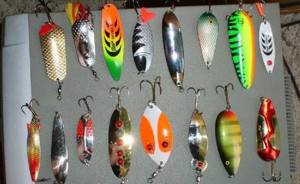
The width in the middle part of the oval relates to its total length in a ratio of no less than one to three. The second equally important selection criterion is size. In pike hunting, they do not stand on ceremony with this parameter; they select large forms with a width of 3–4 centimeters and, accordingly, a length of at least nine. The toothy one does not like the surfaces of spinners in the form of a wave, with different bending amplitudes. The preferred shape is a spoon with a smooth one-sided concavity, similar to the aforementioned spoon.
The colors that attract pike are matte silver and copper. In clear waters, the pure black color has proven itself well. In muddy spring waters, acidic colors of the yellow-green spectrum are applicable. The presence on the body of the instrument of bright attack points or a distinct eye, mostly in red or black tones, sometimes also stimulates biting. Innovations using stickers with holographic tints of colors perfectly catch pike in combination with the selection of the time of daylight light intensity necessary for a suitable play of color.
Important! The weight of the spinner spoon is selected based on the fishing conditions and, in particular, the depth of its implementation.

